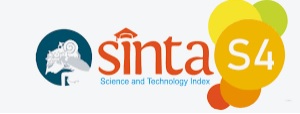Klasifikasi Minat Karir Siswa Sekolah Menengah Atas Menggunakan Algoritma C4.5
Abstract
Many Senior High School (SMA) students experience confusion in determining their next career interests, from not understanding what they have chosen to the influence of the environment in determining their career. So, the researcher aims to help the school convince students in choosing their career interests at SMA Negeri 1 Wringinanom, using SMA student career interest data which is processed using the C4.5 algorithm so that it is more targeted according to the students' interests and talents. A total of 2 classes of secondary data for students in grades X and XI with a total of 76 data with the variables gender, major, academic achievement, non-academic achievement, hobbies, attendance, warning letters, career. Where the data is divided into 4 with accuracy, namely choosing to work 80%, choosing to study 72.2%, choosing to marry 50% and choosing official service 80%. So, students who choose work and officialdom are confident in their choice, those who choose college are not too sure, and those who are most unsure about the choice they make are civil servants with the lowest percentage of confidence.
Keywords: Classification; Career interests; Senior High School; Algorithm C4.5
Â
Abstrak
Banyak siswa Sekolah Menengah Atas (SMA) yang mengalami kebimbangan menentukan minat karir selanjutnya, mulai ketidak pahaman akan yang dipilih hingga pengaruh lingkungan dalam menentukan karir. Maka, peneliti bertujuan untuk membantu pihak sekolah meyakinkan siswa dalam memilih minat karir siswa di SMA Negeri 1 Wringinanom, menggunakan data minat karir siswa SMA yang diproses menggunakan algoritma C4.5 sehingga lebih terarah sesuai dengan minat dan bakat dari siswa. Sebanyak 2 kelas dari data sekunder siswa kelas X dan XI dengan keseluruhan jumlah data sebanyak 76 data dengan variabel jenis kelamin, jurusan, prestasi akademik, prestasi non akademik, hobi, kehadiran, surat peringatan, berkarir. Dimana data dibagi menjadi 4 dengan akurasi yakni memilih bekerja 80%, memilih kulaih 72,2%, memilih menikah 50% dan memilih kedinasan 80%. Maka siswa yang memilih bekerja dan kedinasan yakin dengan pilihannya, yang memilih kuliah tidak terlalu yakin, dan yang paling tidak yakin dengan pilihan yang mereka ambil adalah kediansan dengan persentase keyakinan terendah.
Â
Keywords
References
P. P. Rahayu, “Perancangan Karir Di Masa Pandemi COVID-19 Bagi Siswa Kelas XII SMA Negeri 5 Semarang,†Communnity Development Journal, vol. 3, no. 1, pp. 106–110, 2022.
I. Saripah, D. R. Priliani, dan N. A. Nadhirah, “Indonesian Journal of Guidance and Counseling: Theory and Application,†IJGC, vol. 12, no. 1, pp. 95–118, 2023, doi: 10.15294/ijgc.v12i1.7043.
T. Holland, R. Asri, A. M. Yusuf, dan A. Afdal, “Peningkatan Kematangan Karir Siswa Dengan Teori Holland,†Featured Research 121 SCHOULID: Indonesian Journal of School Counseling, vol. 6, no. 2, pp. 121–132, 2021, doi: 10.23916/08935011.
A. Doahir dan A. N. Qolbi, “Analisis Potensi Siswa Untuk Kuliah Dengan Classification Menggunakan Metode Decision Tree,†Jurnal Poros Teknik, vol. 14, no. 1, pp. 28–32, 2022.
M. Roghib, N. Rahaningsih, dan R. D. Dana, “Penerapan Algoritma C4.5 Untuk Seleksi Penjurusan Siswa Baru Pada Sekolah Menengah Kejuruan (Studi Kasus: Smk Plus Al-Hilal Arjawinangun),†Jurnal Mahasiswa Teknik Informatika, Vol. 8, No. 1, pp. 861-866, Feb 2024.
M. Fikri Rais dan K. Kunci, “Analisis Dampak Kegiatan Ekstrakurikuler Terhadap Hasil Belajar Siswa SMA Adabiah Padang,†Jurnal Pendidikan dan Olahraga, Vol 3, No 6, pp. 7-15, 2020.
R.H. Pambudi dan B.D. Setiawan, “Penerapan Algoritma C4.5 Untuk Memprediksi Nilai Kelulusan Siswa Sekolah Menengah Berdasarkan Faktor Eksternal,†Jurnal Pengembangan Teknologi Informasi dan Ilmu Komputer, Vol. 2, No. 7, pp. 2637-2643, 2018. [Daring]. Tersedia pada: http://j-ptiik.ub.ac.id
A. Purwanto dkk., “Perbandingan Minat Siswa Smu Pada Metode Klasifikasi Menggunakan 5 Algoritma,†Ikraith Informatika, vol. 2, no. 1, pp.. 43-47, 2018.
S. N. Yusuf dan S.N. Haryati, “Klasifikasi dan Klastering Penjurusan Siswa SMA Negeri 3 Boyolali,†Khazanah Informatika, vol 1, no 1, pp. 1-6, 2015.
M. K. Rokhman, S. Sucipto, dan M. Masturi, “Mengatasi Prokrastinasi Akademik Melalui Konseling Behavioristik Dengan Teknik Behavior Contract,†Jurnal Prakarsa Paedagogia, vol. 2, no. 1, pp. 10–18, Jan 2020, doi: 10.24176/jpp.v2i1.4310.
T. Cahyono dan N.M.D. Padmi, “Pemetaan Minat, Bakat dan Karakter Berbasis RIASEC sebagai Acuan Peminatan Lintas Mata Pelajaran pada Jenjang SMA Kurikulum Merdeka,†Islamic Counseling Journal, vol. 6, no. 1, pp. 90–97, 2023, doi: http://dx.doi.org/10.24235/prophetic.v6i1.14764.
T. Restiany, A. Sudrajat, “Manajemen Bimbingan dan Konseling Sekolah untuk Menetapkan Minat Karir Siswa Sekolah Menengah Atas (Studi Kasus di SMA Negeri 1 Majalaya dan SMA Negeri 2 Majalaya Kabupaten Bandung),†Jurnal Ilmiah Ilmu Pendidikan, vol. 5, no. 6, pp. 1849-1861, 2022. [Daring]. Tersedia pada: http://Jiip.stkipyapisdompu.ac.id
J. Amsir dan A.T. Arifyanto, “Faktor-Faktor Penghambat Perencanaan Karir Siswa,†Jurnal Bening, vol. 5, pp. 57–66, 2021, doi: http://dx.doi.org/10.36709/bening.v5i1.12107.
S. Syamsu, N. Suta Wijaya, T. Informatika, dan S. Akba, “Rules Generation Untuk Klasifikasi Data Bakat Dan Minat Berdasarkan Rumpun Ilmu Dengan Decision Tree,†Jurnal Teknologi Informasi dan Komunikasi, vol. 9, no. 1, pp. 40–51, 2019.
A. Mujafar, M. Hanafi, dan M. Maimunah, “Grouping community reading interests using the k-means clustering method (case study: Magelang district library and archive service),†Borobudur Informatics Review, vol. 2, no. 2, pp. 91–102, Des 2022, doi: 10.31603/binr.6810.
How To Cite This :
Refbacks
- There are currently no refbacks.











